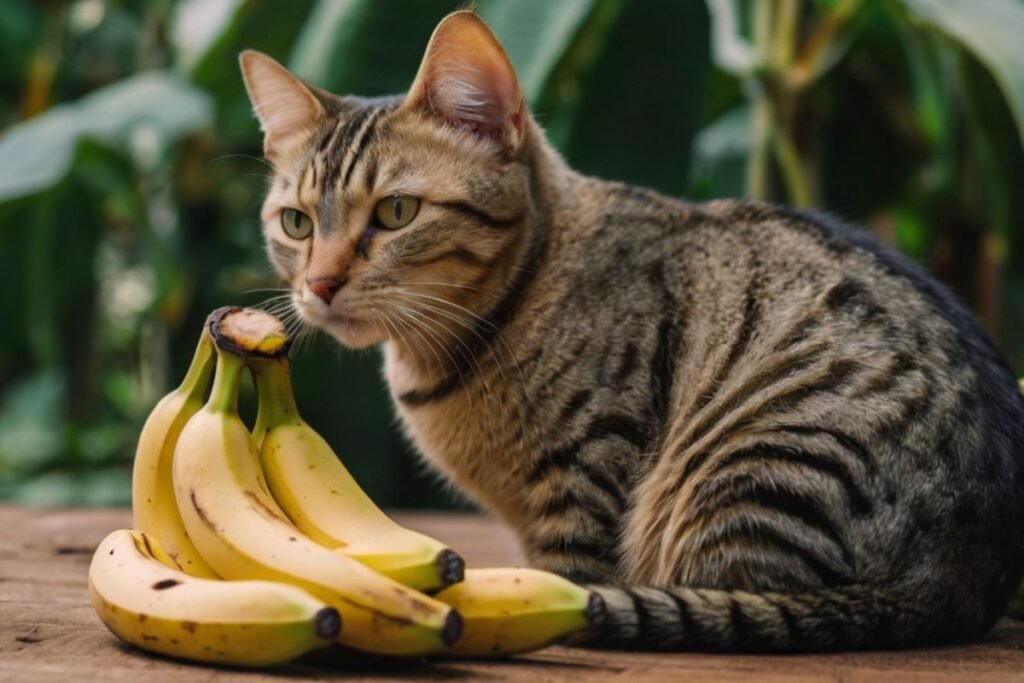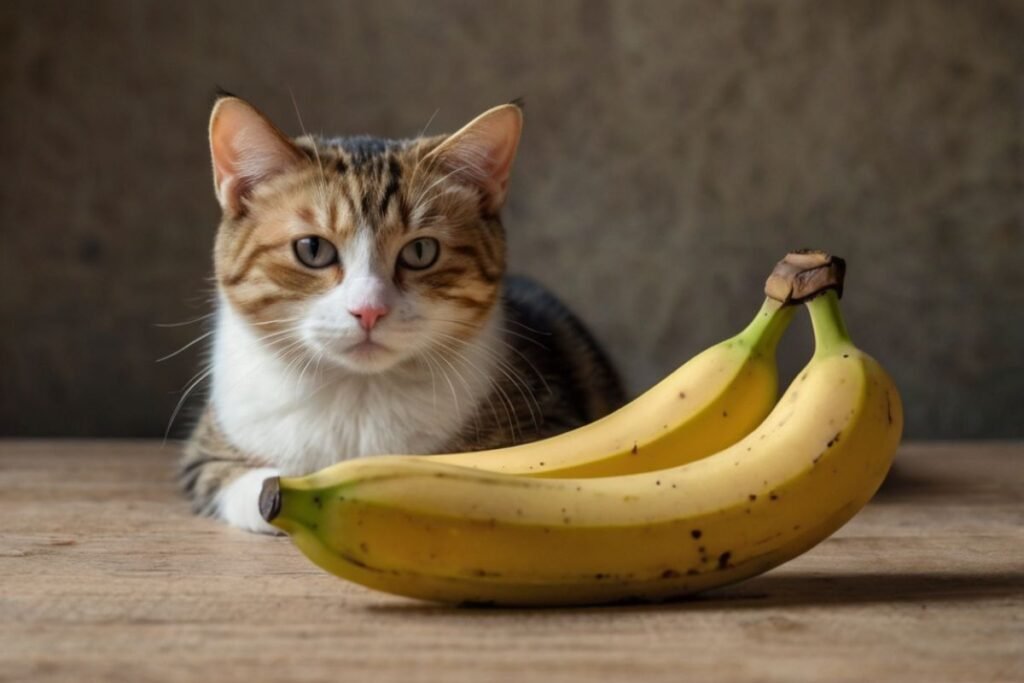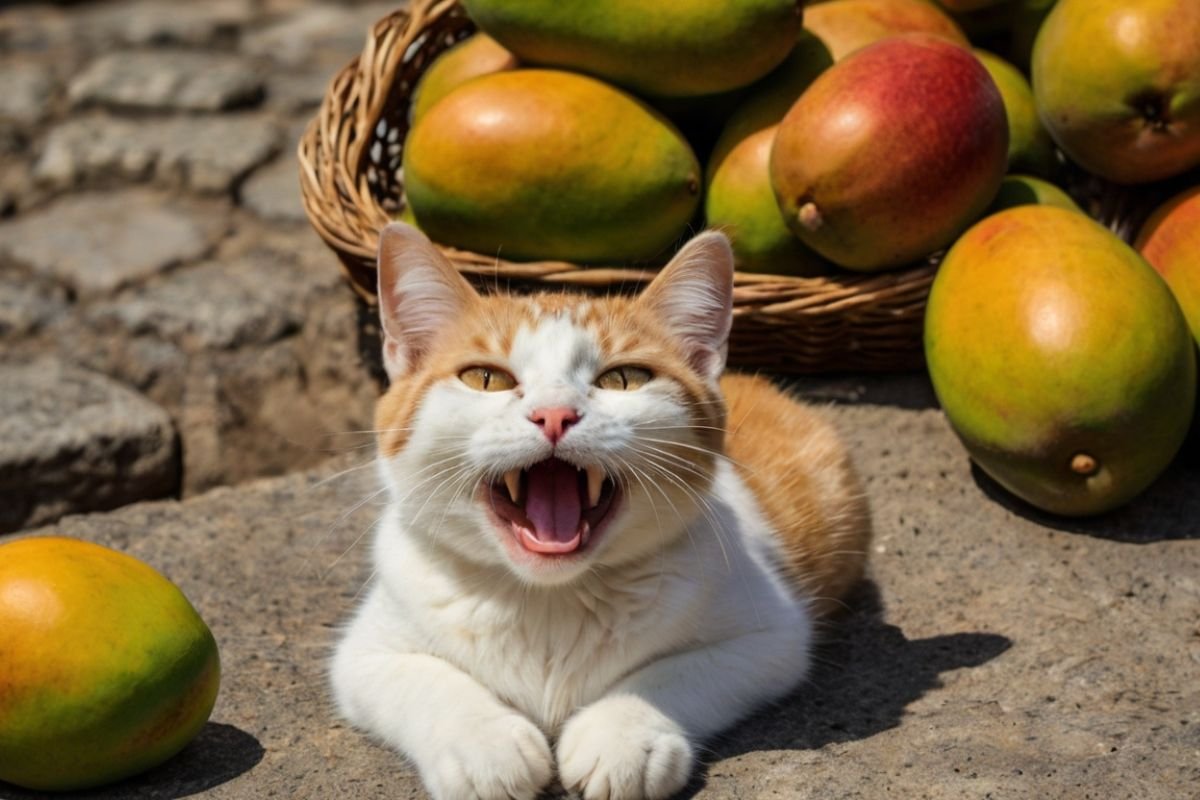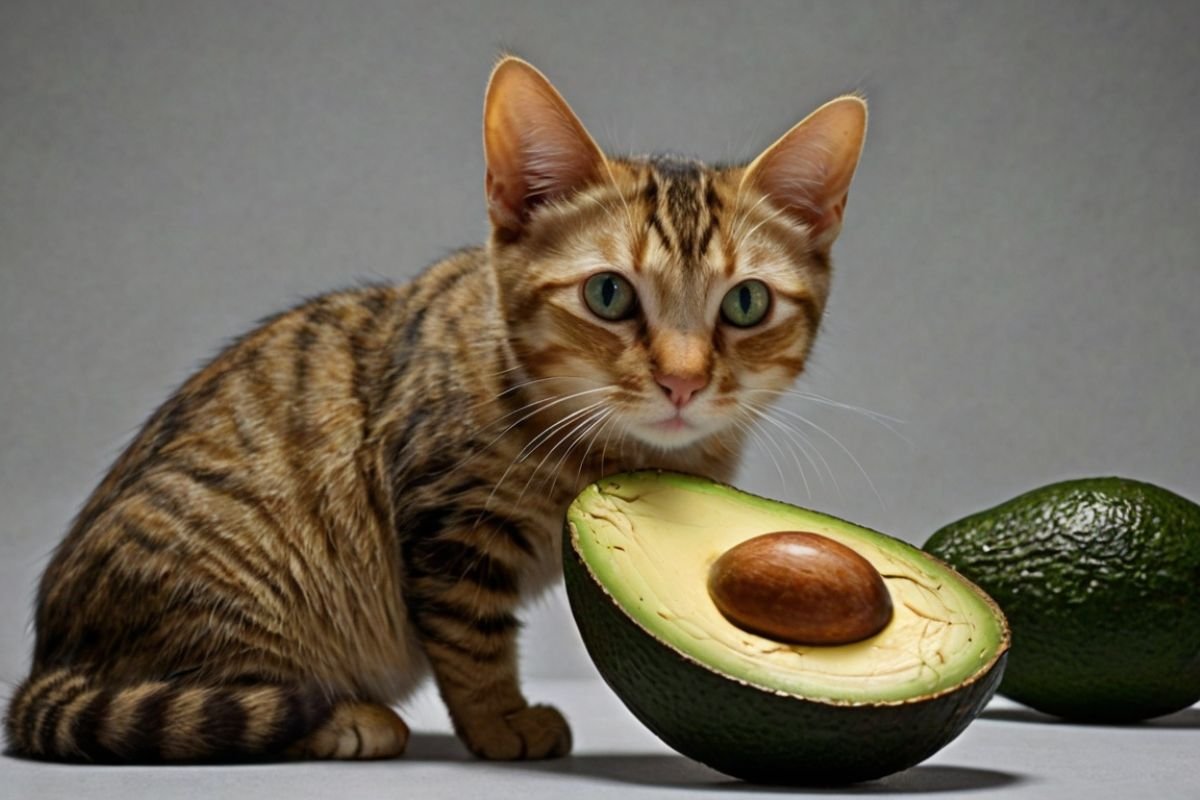Have you ever peeled a banana and noticed your furry friend eyeing it with curiosity? Maybe you’ve wondered if sharing this sweet treat is safe. As a cat parent myself, I often ask these questions when Rio, my orange two-year-old, shows interest in my snacks. Today, I’ll share everything you need to know about cats and bananas – from safety to benefits to serving suggestions.

Table of Contents
First Things First: Are Bananas Safe for Cats?
Yes! The good news is that bananas are not toxic to cats. Unlike foods such as chocolate, grapes, or onions that can harm your cat, bananas won’t poison your feline friend. This means if your cat snags a small piece of banana from your plate, there’s no need to rush to the vet in a panic.
But safe doesn’t always mean ideal. Let’s dig deeper into this topic.
Also read, Can Cats Eat Chocolate?
Understanding Your Cat’s Diet Needs
Cats are what we call “obligate carnivores.” This fancy term simply means they need meat to live. Their bodies are made to digest and use nutrients from animal sources. Their teeth, their guts, even their taste buds – all are designed for a meat-based diet.
In the wild, cats eat prey like mice or birds. These meals give them:
- Protein for muscles
- Taurine for heart and eye health
- Animal fats for energy
Unlike us humans or even dogs, cats don’t need fruits or veggies to stay healthy. Their bodies make most of the vitamins and nutrients they need from meat. This is why your cat food lists meat as the main item.
What’s In a Banana?
Bananas are packed with good stuff for humans:
- Potassium helps our hearts and muscles
- Vitamin B6 helps make red blood cells
- Vitamin C boosts our immune system
- Fiber helps our digestion
- Natural sugars give us energy
This makes bananas a great snack for us, but what about for cats?
Can These Banana Benefits Help Cats?
While cats can get some benefits from the nutrients in bananas, they don’t need them the same way we do. Most of the good stuff in bananas isn’t what cats need most.
For instance, cats don’t need as much plant-based fiber as we do. Their short digestive tracts aren’t made to process lots of plant matter. Also, cats make their own vitamin C – they don’t need to eat it like we do!
Plus, cats can’t even taste sweet things! Their taste buds don’t have the receptors for sweetness. So while you might love a banana for its sweet taste, your cat doesn’t even notice this aspect.
Potential Downsides of Bananas for Cats
While not toxic, bananas do come with some concerns for cats:
High Sugar Content: Bananas contain natural sugars. Too much sugar can lead to weight gain and other health issues in cats, just like in humans. Cats simply aren’t built to process lots of sugar.
Digestive Issues: Some cats may get an upset tummy from eating bananas. The fiber might be too much for their system. This could cause loose stools or gas.
Filling Up on Non-Essentials: If your cat fills up on banana, they might eat less of their regular food. This could mean they miss out on the essential nutrients they really need.
Risk of Choking: Bananas can be sticky. Small bits might pose a choking risk for some cats.
Last week, Rio showed interest in my banana, so I let him lick a tiny bit. He made a funny face and walked away! This is common – many cats show initial interest but don’t actually enjoy the taste or texture.
Why Might Your Cat Want Banana?
If your cat seems drawn to bananas, it might not be for the taste. Here are some reasons:
Curiosity: Cats are naturally curious creatures. Anything new or different might grab their attention.
Texture: Some cats enjoy the soft, mushy texture of banana.
Your Attention: Your cat might just want what you’re having! They see you enjoying something and want to be part of the action.
The Smell: Bananas have a distinct smell that might intrigue your cat, even if they don’t care for the taste.
When Bananas Might Be Helpful
In some rare cases, a bit of banana might actually help your cat:
Constipation: The fiber in bananas can sometimes help ease mild constipation. But there are better ways to help a constipated cat – always talk to your vet first.
Pill Hiding: If your cat needs medicine, a tiny bit of banana might help hide the pill. Though most cats prefer pill pockets made with meat flavors.
Training Treats: If your cat is one of the rare ones who likes banana, tiny bits might work as training treats. Just keep the portions very small!
How Much Banana Is Okay?
If your cat seems to enjoy banana and shows no bad reactions, you can offer it as an occasional treat. Here’s how to do it safely:
Keep It Small: A small slice or even just a tiny nibble is enough. Think of a piece the size of your pinky fingernail or smaller.
Make It Rare: Treats should make up less than 10% of your cat’s diet. For bananas, even less is better – maybe once a week at most.
Watch for Reactions: After giving banana for the first time, watch for any signs of stomach upset or allergic reactions.
Prepare It Right: Always peel the banana. Cut it into small, easy-to-manage pieces. Never add anything like chocolate, honey, or peanut butter, as these can be harmful to cats.
Better Treat Options for Cats
While bananas aren’t harmful, there are treats that better match your cat’s natural diet:
Commercial Cat Treats: These are made to meet cat nutritional needs while still being tasty.
Small Bits of Plain Cooked Meat: A tiny piece of boiled chicken or turkey with no salt or spices.
Freeze-Dried Meat Treats: These preserve the nutrients cats need and have a crunchy texture many cats love.
Cat Grass: If your cat likes plants, cat grass is grown just for them to nibble on.
Last month, I found that Rio goes crazy for freeze-dried chicken treats. These align much better with his natural diet than any fruit would!
Signs Your Cat Should Not Eat Banana
Some cats should skip the banana entirely:
Diabetic Cats: The sugar content, even if natural, can be a problem.
Overweight Cats: These cats need to watch all extra calories.
Cats with Digestive Issues: If your cat has IBS or other digestive problems, new foods might trigger them.
Cats on Special Diets: If your vet has prescribed a special diet, stick to it unless they say it’s okay to add treats.
Always check with your vet before adding any new food to your cat’s diet, especially if they have health concerns.
What To Do If Your Cat Eats Too Much Banana
If your cat somehow gets into a whole banana, don’t panic. Since bananas aren’t toxic, this isn’t an emergency. But you should:
Watch for Signs of Distress: Look for vomiting, diarrhea, lethargy, or loss of appetite.
Offer Fresh Water: Make sure your cat stays hydrated.
Call Your Vet If Needed: If your cat shows signs of distress or you’re worried, call your vet for advice.
Return to Normal Diet: Don’t offer any more treats for a day or two. Let their system settle.
The Bottom Line on Bananas
To sum it all up:
- Bananas are safe but not necessary for cats
- Most cats don’t need or want bananas
- If given, they should be a rare, small treat
- Always peel and cut into tiny pieces
- Watch for any bad reactions
- Consider treats made for cats instead
Common Questions About Cats and Bananas

Can kittens eat bananas?
Kittens have even more specific nutritional needs than adult cats. They need foods that support their rapid growth. It’s best to stick to kitten food and treats made just for them. Save any food experiments for when they’re fully grown.
What about banana peels?
No, cats should never eat banana peels. They’re tough to digest and could cause blockages. They might also have pesticide residue. Always peel bananas before offering a small bit to your cat.
Can cats eat banana bread or banana-flavored foods?
Most banana-flavored foods made for humans contain other ingredients that might harm cats. Banana bread often has sugar, butter, and sometimes nuts or chocolate chips – all things cats should avoid. Stick to plain, fresh banana if you want to share with your cat.
My cat loves bananas! Is this normal?
While not common, some cats do enjoy unusual foods like bananas. As long as your vet says it’s okay and you keep the portions tiny, this quirk isn’t harmful. Every cat has their own strange likes and dislikes – just like people!
What other fruits can cats eat?
Most cats don’t need fruits, but some safe options in tiny amounts include:
- Small bits of seedless watermelon
- Tiny pieces of apple (no seeds)
- A lick of strawberry
Always remove seeds, pits, peels, and rinds, which can be choking hazards or contain harmful compounds.
Why We Ask These Food Questions
As cat parents, we want to share our lives with our pets. Food is a big part of how we show love and care. It’s natural to wonder if the foods we enjoy might also bring joy to our cats.
Plus, we want to be ready in case of accidents. Cats can be sneaky! Knowing what foods are safe helps us stay calm if our curious cats get into something they shouldn’t.
When Rio first came to live with me, I spent hours researching what foods were safe. Even though he shows little interest in human foods, I feel better knowing what’s okay and what’s not.
Building Healthy Cat Food Habits
Instead of focusing on sharing human foods with your cat, here are some ways to build good cat food habits:
Regular Feeding Times: Cats thrive on routine. Feed at the same times each day.
Fresh Water Always: Keep clean water available at all times.
Proper Portions: Most cats need less food than we think. Talk to your vet about the right amount.
Slow Feeders: If your cat eats too fast, try puzzle feeders or slow-feed bowls.
Quality Cat Food: Look for foods where meat is the first ingredient.
Limited Treats: Keep treats to less than 10% of daily calories.
When to Talk to Your Vet About Diet
Some signs it’s time to discuss your cat’s diet with a vet:
- Weight gain or loss
- Dull coat or skin problems
- Low energy
- Digestive issues
- Food obsession or loss of appetite
Your vet can help create a feeding plan that keeps your cat at their best.
My Experience With Cat Food Curiosity
As I mentioned, my cat Rio is fairly typical when it comes to fruit. He might sniff at what I’m eating, but rarely shows real interest in non-meat foods. Once, I dropped a bit of banana on the floor. He ran over to check it out, sniffed it, licked it once, and then walked away with what I swear was a look of disgust!
This taught me an important lesson – just because we can share something with our cats doesn’t mean we should. Rio is happiest with his cat food and the occasional meat treat. Seeing his health and happiness is worth more than the brief fun of sharing my snack.
Final Thoughts
Cats and bananas aren’t natural partners. While a tiny taste won’t hurt most cats, it’s not something they need. Our cats rely on us to provide the right nutrition for their unique bodies.
The best way to show love to your cat isn’t by sharing your banana – it’s by understanding and respecting their natural diet needs. Good quality cat food, plenty of fresh water, and the occasional cat-appropriate treat will keep your feline friend healthy and happy for years to come.
If you’re ever in doubt about what to feed your cat, your vet is the best source of advice. They know your specific cat and their health needs.
Remember – the goal isn’t to make our cats eat like us. The goal is to help them thrive as the wonderful, meat-eating creatures they are!
What foods has your cat shown interest in? Have you ever had to chase down a food thief in your home? The stories of cats and their food adventures always bring a smile to my face. Keep those tails high and those whiskers twitching, friends!

Shahriar Robin is the creator of WhatPetsCanEat.com, a passionate pet lover and dedicated cat dad to Rio, a curious two-year-old orange feline who inspired this website. With a love for animals and a knack for research, Shahriar shares trusted, easy-to-understand information to help fellow pet owners make safe, healthy food choices for their furry friends.


